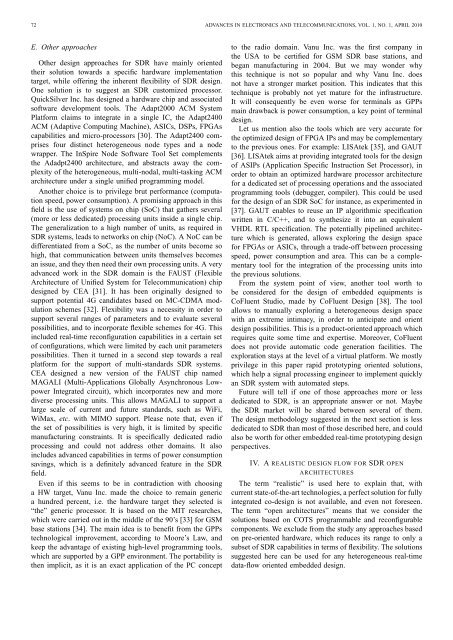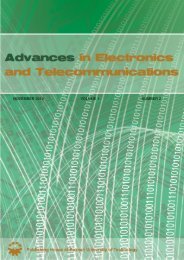channel - Advances in Electronics and Telecommunications
channel - Advances in Electronics and Telecommunications
channel - Advances in Electronics and Telecommunications
Create successful ePaper yourself
Turn your PDF publications into a flip-book with our unique Google optimized e-Paper software.
72 ADVANCES IN ELECTRONICS AND TELECOMMUNICATIONS, VOL. 1, NO. 1, APRIL 2010<br />
E. Other approaches<br />
Other design approaches for SDR have ma<strong>in</strong>ly oriented<br />
their solution towards a specific hardware implementation<br />
target, while offer<strong>in</strong>g the <strong>in</strong>herent flexibility of SDR design.<br />
One solution is to suggest an SDR customized processor.<br />
QuickSilver Inc. has designed a hardware chip <strong>and</strong> associated<br />
software development tools. The Adapt2000 ACM System<br />
Platform claims to <strong>in</strong>tegrate <strong>in</strong> a s<strong>in</strong>gle IC, the Adapt2400<br />
ACM (Adaptive Comput<strong>in</strong>g Mach<strong>in</strong>e), ASICs, DSPs, FPGAs<br />
capabilities <strong>and</strong> micro-processors [30]. The Adapt2400 comprises<br />
four dist<strong>in</strong>ct heterogeneous node types <strong>and</strong> a node<br />
wrapper. The InSpire Node Software Tool Set complements<br />
the Adadpt2400 architecture, <strong>and</strong> abstracts away the complexity<br />
of the heterogeneous, multi-nodal, multi-task<strong>in</strong>g ACM<br />
architecture under a s<strong>in</strong>gle unified programm<strong>in</strong>g model.<br />
Another choice is to privilege brut performance (computation<br />
speed, power consumption). A promis<strong>in</strong>g approach <strong>in</strong> this<br />
field is the use of systems on chip (SoC) that gathers several<br />
(more or less dedicated) process<strong>in</strong>g units <strong>in</strong>side a s<strong>in</strong>gle chip.<br />
The generalization to a high number of units, as required <strong>in</strong><br />
SDR systems, leads to networks on chip (NoC). A NoC can be<br />
differentiated from a SoC, as the number of units become so<br />
high, that communication between units themselves becomes<br />
an issue, <strong>and</strong> they then need their own process<strong>in</strong>g units. A very<br />
advanced work <strong>in</strong> the SDR doma<strong>in</strong> is the FAUST (Flexible<br />
Architecture of Unified System for Telecommunication) chip<br />
designed by CEA [31]. It has been orig<strong>in</strong>ally designed to<br />
support potential 4G c<strong>and</strong>idates based on MC-CDMA modulation<br />
schemes [32]. Flexibility was a necessity <strong>in</strong> order to<br />
support several ranges of parameters <strong>and</strong> to evaluate several<br />
possibilities, <strong>and</strong> to <strong>in</strong>corporate flexible schemes for 4G. This<br />
<strong>in</strong>cluded real-time reconfiguration capabilities <strong>in</strong> a certa<strong>in</strong> set<br />
of configurations, which were limited by each unit parameters<br />
possibilities. Then it turned <strong>in</strong> a second step towards a real<br />
platform for the support of multi-st<strong>and</strong>ards SDR systems.<br />
CEA designed a new version of the FAUST chip named<br />
MAGALI (Multi-Applications Globally Asynchronous Lowpower<br />
Integrated circuit), which <strong>in</strong>corporates new <strong>and</strong> more<br />
diverse process<strong>in</strong>g units. This allows MAGALI to support a<br />
large scale of current <strong>and</strong> future st<strong>and</strong>ards, such as WiFi,<br />
WiMax, etc. with MIMO support. Please note that, even if<br />
the set of possibilities is very high, it is limited by specific<br />
manufactur<strong>in</strong>g constra<strong>in</strong>ts. It is specifically dedicated radio<br />
process<strong>in</strong>g <strong>and</strong> could not address other doma<strong>in</strong>s. It also<br />
<strong>in</strong>cludes advanced capabilities <strong>in</strong> terms of power consumption<br />
sav<strong>in</strong>gs, which is a def<strong>in</strong>itely advanced feature <strong>in</strong> the SDR<br />
field.<br />
Even if this seems to be <strong>in</strong> contradiction with choos<strong>in</strong>g<br />
a HW target, Vanu Inc. made the choice to rema<strong>in</strong> generic<br />
a hundred percent, i.e. the hardware target they selected is<br />
“the” generic processor. It is based on the MIT researches,<br />
which were carried out <strong>in</strong> the middle of the 90’s [33] for GSM<br />
base stations [34]. The ma<strong>in</strong> idea is to benefit from the GPPs<br />
technological improvement, accord<strong>in</strong>g to Moore’s Law, <strong>and</strong><br />
keep the advantage of exist<strong>in</strong>g high-level programm<strong>in</strong>g tools,<br />
which are supported by a GPP environment. The portability is<br />
then implicit, as it is an exact application of the PC concept<br />
to the radio doma<strong>in</strong>. Vanu Inc. was the first company <strong>in</strong><br />
the USA to be certified for GSM SDR base stations, <strong>and</strong><br />
began manufactur<strong>in</strong>g <strong>in</strong> 2004. But we may wonder why<br />
this technique is not so popular <strong>and</strong> why Vanu Inc. does<br />
not have a stronger market position. This <strong>in</strong>dicates that this<br />
technique is probably not yet mature for the <strong>in</strong>frastructure.<br />
It will consequently be even worse for term<strong>in</strong>als as GPPs<br />
ma<strong>in</strong> drawback is power consumption, a key po<strong>in</strong>t of term<strong>in</strong>al<br />
design.<br />
Let us mention also the tools which are very accurate for<br />
the optimized design of FPGA IPs <strong>and</strong> may be complementary<br />
to the previous ones. For example: LISAtek [35], <strong>and</strong> GAUT<br />
[36]. LISAtek aims at provid<strong>in</strong>g <strong>in</strong>tegrated tools for the design<br />
of ASIPs (Application Specific Instruction Set Processor), <strong>in</strong><br />
order to obta<strong>in</strong> an optimized hardware processor architecture<br />
for a dedicated set of process<strong>in</strong>g operations <strong>and</strong> the associated<br />
programm<strong>in</strong>g tools (debugger, compiler). This could be used<br />
for the design of an SDR SoC for <strong>in</strong>stance, as experimented <strong>in</strong><br />
[37]. GAUT enables to reuse an IP algorithmic specification<br />
written <strong>in</strong> C/C++, <strong>and</strong> to synthesize it <strong>in</strong>to an equivalent<br />
VHDL RTL specification. The potentially pipel<strong>in</strong>ed architecture<br />
which is generated, allows explor<strong>in</strong>g the design space<br />
for FPGAs or ASICs, through a trade-off between process<strong>in</strong>g<br />
speed, power consumption <strong>and</strong> area. This can be a complementary<br />
tool for the <strong>in</strong>tegration of the process<strong>in</strong>g units <strong>in</strong>to<br />
the previous solutions.<br />
From the system po<strong>in</strong>t of view, another tool worth to<br />
be considered for the design of embedded equipments is<br />
CoFluent Studio, made by CoFluent Design [38]. The tool<br />
allows to manually explor<strong>in</strong>g a heterogeneous design space<br />
with an extreme <strong>in</strong>timacy, <strong>in</strong> order to anticipate <strong>and</strong> orient<br />
design possibilities. This is a product-oriented approach which<br />
requires quite some time <strong>and</strong> expertise. Moreover, CoFluent<br />
does not provide automatic code generation facilities. The<br />
exploration stays at the level of a virtual platform. We mostly<br />
privilege <strong>in</strong> this paper rapid prototyp<strong>in</strong>g oriented solutions,<br />
which help a signal process<strong>in</strong>g eng<strong>in</strong>eer to implement quickly<br />
an SDR system with automated steps.<br />
Future will tell if one of those approaches more or less<br />
dedicated to SDR, is an appropriate answer or not. Maybe<br />
the SDR market will be shared between several of them.<br />
The design methodology suggested <strong>in</strong> the next section is less<br />
dedicated to SDR than most of those described here, <strong>and</strong> could<br />
also be worth for other embedded real-time prototyp<strong>in</strong>g design<br />
perspectives.<br />
IV. A REALISTIC DESIGN FLOW FOR SDR OPEN<br />
ARCHITECTURES<br />
The term “realistic” is used here to expla<strong>in</strong> that, with<br />
current state-of-the-art technologies, a perfect solution for fully<br />
<strong>in</strong>tegrated co-design is not available, <strong>and</strong> even not foreseen.<br />
The term “open architectures” means that we consider the<br />
solutions based on COTS programmable <strong>and</strong> reconfigurable<br />
components. We exclude from the study any approaches based<br />
on pre-oriented hardware, which reduces its range to only a<br />
subset of SDR capabilities <strong>in</strong> terms of flexibility. The solutions<br />
suggested here can be used for any heterogeneous real-time<br />
data-flow oriented embedded design.







